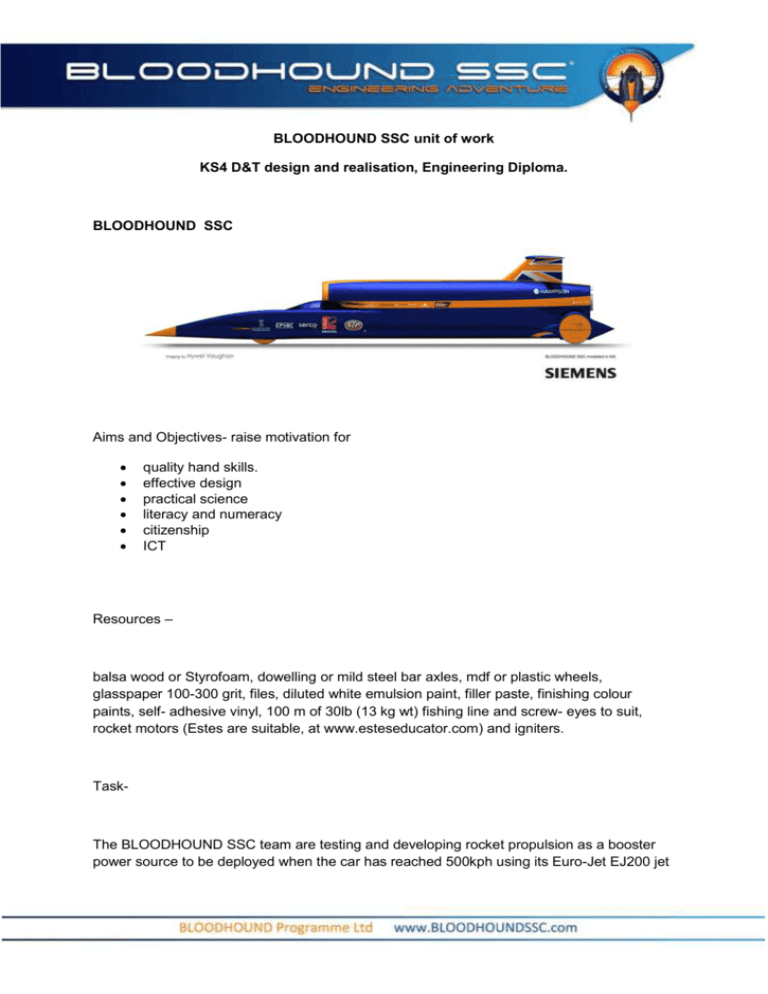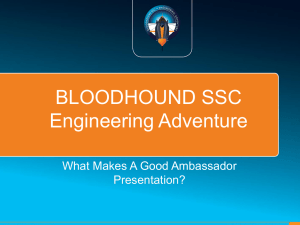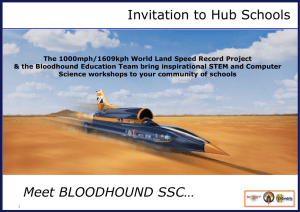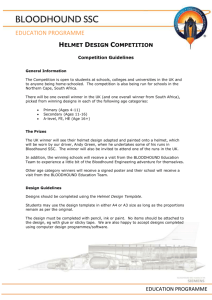BLOODHOUND SSC unit of work KS4 D&T design and realisation
advertisement

BLOODHOUND SSC unit of work KS4 D&T design and realisation, Engineering Diploma. BLOODHOUND SSC Aims and Objectives- raise motivation for quality hand skills. effective design practical science literacy and numeracy citizenship ICT Resources – balsa wood or Styrofoam, dowelling or mild steel bar axles, mdf or plastic wheels, glasspaper 100-300 grit, files, diluted white emulsion paint, filler paste, finishing colour paints, self- adhesive vinyl, 100 m of 30lb (13 kg wt) fishing line and screw- eyes to suit, rocket motors (Estes are suitable, at www.esteseducator.com) and igniters. Task- The BLOODHOUND SSC team are testing and developing rocket propulsion as a booster power source to be deployed when the car has reached 500kph using its Euro-Jet EJ200 jet engine from the Typhoon fighter. This project is to help students to understand how important aerodynamics, weight and above all quality of engineering design, are to the performance of the car. Students are to construct their own rocket powered BLOODHOUND SSC Land Speed Record car and race it on the playground, running down a tethered line in a drag race format, one on one. BLOODHOUND SSC is being developed to be the fastest car on earth. Just like BLOODHOUND you will have to design your car to stay on the ground but not have so much drag that it will not reach maximum speed over the course distance. The cars will reach an actual speed of approximately 100 kph (62.5mph) and travel 50+ metres at speed using the standard rocket motor. Students can calculate their scale speed by timing the run and comparing the dimensions of their car with the BLOODHOUND data sheets. The underneath of the cars must allow the fishing line to run through the screw eyes without dragging. Students can build in their own solutions to this problem. The rocket motors are available in various sizes from companies such as Estes and the space available will determine the running time choice of rocket motor. Safe use of these motors is paramount and suitable instructions come with the motors. Main rules being: Always use the correct igniters and launch unit. Do not allow any students to stand behind the car at launch. Be aware that the rocket motor will be ejected from the car at the end of its burn time. (This is because a small charge is ignited at the end of the burn to eject a parachute when used as a vertical rocket). So a loose fit in the hole in the car is essential, to avoid destruction of the car at the end of a run. Do not allow the students to handle rocket motors after firing as the residual chemicals may still be hot and are poisonous. Dispose of the spent motors responsibly. Build a car for demonstration. Show this in action to the students at the start of the project. Lesson 1 Starter Activity- 5 mins- Show DVD clip of Thrust SSC at full speed and introduce BLOODHOUND SSC as its successor, Use the fact sheets for a resource. (See the scientific and engineering challenge of the car on the web-site) Teacher Input- 10 mins- show the students the resources available and explain the task. Discuss the idea of speed and what shapes look fast. Show a Gant chart of the project on a whiteboard to help with a plan for making. Student Task- 20 mins- resources- A3 paper and pencils -sketch shapes of cars that they think will be fast. Try to use 3D – freehand isometric. Teacher Input and Plenary- 5 mins- Introduce the materials going to be used as the car (balsa or Styrofoam) and discuss how the shapes need to visualised in the material in 3D. Homework- Find out about the rival cars to BLOODHOUND SSC and look at their shapes. Are they a real threat? Lesson 2 Starter Activity- In pairs-10 mins. Give out small pieces of balsa or foam and get students to break them, try crushing them and report to a partner on the qualities and constraints of these materials. Teacher Input - 15 mins- Introduce the physical speed these models will reach. Ask them to think of the forces involved and Q&A them about what forces apply here. Show them the rocket motor and emphasise the hole size constraints to their designs. Mention practical processes for drilling the motor hole and shaping the car. Styrofoam is lighter than balsa and has poor axle location properties so it will need to be laminated with 2mm or 3 mm MDF. Show students how to do this either vertically or horizontally. Show a picture of BLOODHOUND SSC. BLOODHOUND SSC STYROFOAM OPTION STYROFOAM/MDF LAMINATION 3mm MDF 65 mm ALTERNATIVE LAMINATION 3mm MDF STYROFOAM Student Task- 20 mins- Draw designs neatly with as much detail as possible. Show plan, side and both ends. Homework Complete drawings and cutting order ready to prepare car body materials next lesson. Teacher/Technician to glue up any laminations. 50mm 225mm or use balsa to same dimensions Lesson 3 Starter Activity- in pairs- Write down 3 uses of jet power. Swap sheets and write alongside them some design constraints for that application. Share your findings. Teacher Input- 5 mins – show students how to make templates from their designs ready to be glued on the material. Show process for drilling motor hole. (Could be pre-drilled- 17 – 19mm according to motor size.) Student task- 30 mins- choose final shape and draw views full size. Cut out templates and glue to the car body blanks. While this is drying work out where the axle holes will go and how the 4 wheels are being sited. Mark hole positions for drilling- use surface table and height gauge for accuracy. Use the pillar drill to drill axles to suit straws or other hole bearings. This is best done before any shaping takes place, as there will be better alignment of holes from a square shape. Plenary- 5 mins – Discuss progress and importance of accuracy for BLOODHOUND SSC. Homework- Plan the colour scheme and update plan for making. Lesson 4 Starter Activity- 10 mins - Write down 5 words that mean speed. Call out for teacher to record on white board. Use this word bank to think of a name for your car. Teacher Input- 10 mins- Demonstrate the shaping process using a coping saw to remove the main material and glass paper wrapped around an old file or dowel to fine finish the shape. Remind students about the underneath of the car needing to run along the fishing line cleanly. Student Task- 30 mins- Cut shape carefully and start to sand. Ensure that all sides are true and symmetrical. Plenary- 2 mins- Quick check of progress. Homework- Complete all drawings and edit plan for making to take account of progress. Lesson 5 Starter Activity- 5 mins- In pairs- Show BLOODHOUND SSC car design on whiteboard. Students to tell each other where they think the main airflow goes over the car. Teacher Input- 5 mins- Use the fact sheets to show the students the airflow over the car. Remind them about sanding a smooth finish prior to filling and painting. Student Task- 40 mins- Continue shaping and sanding until a fine finish is achieved. Use filler if necessary to finish. Painting primer can be done either with spray cans or brush finish then sanded. Homework- Write up progress and amend making plan. Lesson 6 Starter Activity- 10 mins- Give students a forces word list from the fact sheets and challenge them to select the forces acting on their car. All the forces act on the cars. Teacher Input- 5 mins- Explain to the students that even though their car is a small model the forces are still going to effect performance. Show how to paint cars using a painting station or booth- a large cardboard box with one side cut out is suitable in a well ventilated area. Student Task- 30 mins- Check axles fit properly and turn freely. Continue to finish painting. If the cars are painted and dry, run the axles in by moving the car on the bench. Turn the car over and measure and mark the centre line of the car. Place screw-eyes on centre line and fit just inside axles. UNDERSIDE OF CAR SCREW-EYES Plenary- 5mins- Appraise finished cars with the students and give target time to unfinished ones. Homework – Give out BLOODHOUND fact sheets and ask students to start to prepare a short presentation about their car to be given as part of the evaluation process after running the cars next lesson. Lesson 7 Starter activity- 5 mins - In pairs- Discuss and write down 5 safety rules to be applied when running the cars. Teacher input- 5 mins - Define safety rules and ask students to write them down to complete their list of rules. Explain the start procedure and retrieval of both cars: Fit igniters to rocket motors- be careful they are fragile. Fit motor in the hole in rear of both cars. Slip fishing line through screw-eyes and reattach to fixing point – simplest way to do this is a nail tapped into tarmac at both ends. Attach the launcher leads to the igniters- the correct launchers must be used. Count down and race. Students slide the cars off the fishing line at the far end and reattach fishing line. Student Task- 40 mins - Run cars in turn. Time cars and record results on a spreadsheetcould be done later. Observe performance of cars and see how stable they are under power. Video capture will enable speeds to be calculated as the run time will be very short and using a stopwatch will yield large uncertainties. Homework- Continue with presentation preparation. Lesson 8 Presentation lesson – Students present 2-3 minutes about their car and its performance. Teacher to set up a voting system to find favourite car, as well as use the results to find fastest one. Create a display of cars after assessment. BLOODHOUND ROCKET CAR ASSESSMENT STUDENT NAME DESIGN PLAN OF MAKING QUALITY OF MAKING GRADE STUDENT NAME RUN 1 RUN 2 RUN 3 PLACING









